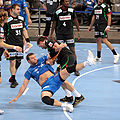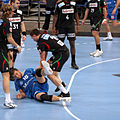Serial photography
As a series photograph or series Photography is defined as a form of expression of photography , in which a series of photographic images to a series of combined or series.
history
In the development of photography , instant or momentary photographs became possible for the first time from 1870 and could be combined into series. The term chronophotography or photochronography (χρόνος: Greek : "time") was also used for these series . Eadweard Muybridge photographed a. a. 1872 for Leland Stanford the phases of movement of a galloping horse with initially 12, then 24 and finally 36 synchronized cameras , whereby the first series photographs in the narrower sense were taken. Muybridges published his work in the volumes Animal Locomotion and The Human Figure in Motion , which consisted exclusively of picture panels with series photographs. Other pioneers of moment photography and its further development into moving images are Étienne-Jules Marey and the inventor of the focal plane shutter Ottomar Anschütz . These early serial shots were also fundamental to the development of the film .
Series of images
Series recordings on one or more image carriers are used today to analyze movement, for example in sports. While the cameras used for this used to make professional use necessary for reasons of cost and effort, with the digital means possible today, but also with cheap simple cameras, applications in the hobby and art area are also feasible. The boundaries between photomontage and film cameras or stroboscopic recordings are fluid. In the case of cinema films , one speaks of series photography and phase images.
The series of images can both bridge time , for example show a chronology (a tree at different times of the year), as well as bridge space, i.e. contrast scenes from different regions of the world.

In sports photography , cameras with a high image sequence (5 to 10 images per second) are used in many sports in order to be able to capture “the right moment” in the image. Usually only one image from this series is published.
Example of a series recording in a handball game:
Series of images in a single image
The individual images of a series of images can be exposed on a single negative or positive; one then speaks of a multiple exposure . The combination with a stroboscopic flash , with which, for example, the individual phases of a movement can be captured in a single image, is particularly popular .
This form of serial photography is also used in chronophotography. For example, Marey's chronophotographic shotgun from 1883 captured a series of exposures on a single plate .
Individual evidence
- ↑ With the advent of the technical possibility, both terms were used. Eg serial photographs of falling drops . In: The Philosopher's Stone , 15 vol. Pp 91-92 (1896).
- ^ Hans Christian Adam (Ed.): Eadweard Muybridge. The Human and Animal Locomotion Photographs. Taschen, Cologne 2010, ISBN 978-3-8365-0941-1
- ↑ Advertisement for Anschütz's quick viewer for reproducing photographic image series. Retrieved August 5, 2017 . (Archive of the Otto Lilienthal Museum )






